Overview
Together with the graduate and undergraduate students and postdoc fellow at the University of Victoria (UVic) and research collaborators around the world, we have been putting together a low-earth-orbit (LEO) satellite network (LSN) testbed, with access to SpaceX’s Starlink and Eutelsat’s OneWeb user terminals (UT, also known as “dish”) and in contact with Amazon’s Project Kuiper and Telesat (Canada)’s Lightspeed, four current leading LSN service providers covering both consumer and business customers.
We first explored the Starlink access network performance near Seattle and other point-of-presence (PoP) locations and revealed the Starlink backbone network around the world, with publications that attracted considerable academic and industry attention. We are among the first to identify and confirm the Starlink UT-satellite handover behaviors every 15 seconds globally synchronized off each minute, and proposed techniques to mitigate the handover packet loss and delay spikes and their impact in the transport and application layers of the network protocol stack.
The work focusing on low-latency live video streaming over LSNs received the Dynamic Adaptive Streaming over HTTP (DASH, a standard powering almost all the videos we see over the Internet nowadays) Industry Forum (DASH-IF) Prize at ACM Multimedia Systems 2024. We also open sourced our code and released our datasets to the research community, under the Low Earth Network of Satellites (LENS) initiative. The dataset contains the packet delay and loss measurement data in terabytes from more than a dozen dishes around the world and is updated monthly, and has been downloaded more than 400 times in less than a year, enabling trace-driven network simulation and emulation research worldwide.
We further made our research testbed accessible through RIPE Atlas (European Internet operators), LEOScope (an initiative led by the University of Surrey and Microsoft Research India) and Starlink Status (a user-contributed measurement platform), and our research development is disseminated to the broader public through Reddit Starlink Engineering, in addition to traditional means such as academic conferences, research journals and invited talks. We also hosted indigenous teenager’s summer camp (VJKF 2024 program) on bridging the digital divide and participated in the projects to bring connectivity to indigenous kids attending schools on daily extended commutes.
Some of our research tools and bug fixes have been adopted by Starlink in its mobile app and backbone network and used by its more than 9 million users in more than 150 countries and regions. Most recently, we are comparing the performance of Starlink and OneWeb at different locations around the world given their different technologies, LEO parameters and targeted customers, and correlating UT, communicating satellites and landing ground stations without UT revealing such information to improve the handover performance and behaviors.
A list of our work, papers, datasets and impact can be found below.
Contact
Dr. Jianping Pan, University of Victoria
Email: pan at uvic.ca
What’s New
PolarLink is a technology demonstration CubeSat mission led by UVic CfAR and funded by Defense Research Development Canada (DRDC). The mission involves the development and launch of a 6U CubeSat equipped with multiple communication payloads, including:
- Ka-band terminal for satellite-to-ground communications
- SDA-compliant optical terminal for inter-satellite links with commercial LEO constellations
The goal is to explore high-bandwidth, low-latency communication solutions for the Canadian Arctic.
See “Tools -> LEOViz” below for more information.
See also our research publications, datasets and impacts on OneWeb at https://oac.uvic.ca/oneweb.
Publications
18. GeoFeed in the wild: A case study on StarlinkISP.net, [Paper]
Jianping Pan, Jinwei Zhao
IAB Workshop on IP Address Geolocation (ip-geo) (ipgeows)
Abstract
Low-earth-orbit (LEO) satellite networks, exemplified by SpaceX’s Starlink, Eutelsat’s OneWeb, Amazon’s Project Kuiper and Telesat’s Lightspeed and followed by others, have revolutionized the Internet access, particularly in rural areas, in the air and on the sea, where traditionally Internet access technologies are unavailable, too costly, very limited or simply impossible. Besides lower latency and higher capacity on the ground, LEO networks also introduce new challenges such as frequent satellite handover. For example, Starlink hands over every 15 seconds, fixed at the 12th, 27th, 42nd and 57th seconds off each minute. With a different satellite and likely ground station, the latency between user terminal (i.e., dish) and user’s home point-of-presence (PoP) changes greatly, which confuses TCP congestion control algorithms (i.e., a sudden latency increase leads to premature timeout and decrease results in packet reordering and duplicate acknowledgment). TCP and QUIC adjustment and bitrate adaptation are used to improve protocol and application performance over LEO networks.
17. QTER: QoS-Aware Three-Dimensional Efficient and Reliable Routing for LEO Satellite Networks
Jinkai Zheng, Tom H. Luan, Guanjie Li, Yanfeng Zhang, Mingfeng Yuan, Jianping Pan
IEEE Internet of Things Journal, doi: 10.1109/JIOT.2025.3564417
Abstract
Low Earth Orbit (LEO) satellite networks offer a promising approach for achieving global coverage and high-speed Internet access. However, the existing communication frameworks within these networks may result in low robustness and reliability. This paper introduces QTER, a novel and lightweight routing framework specifically designed for LEO networks, aimed at addressing these challenges. Our contributions are threefold. First, QTER establishes a cost-effective and reliable routing framework that accommodates a variety of applications with distinct Quality of Service (QoS) requirements. By enabling multi-path routing, the framework minimizes costs while ensuring end-to-end reliability, thus enhancing adaptability to diverse service demands. Second, we leverage the unique structural characteristics of LEO satellite networks by modeling the satellite constellation as a three-dimensional network, wherein higher-shell satellites serve as management satellite nodes (MSNs) to coordinate routing strategies among lower-shell satellites. This architecture significantly improves system efficiency and adaptability. Third, we propose a failure recovery mechanism that allows MSNs to relay packets when lower-orbit satellites are rendered unavailable due to environmental factors, thereby enhancing system robustness. Extensive simulations demonstrate that QTER exhibits resilience to node failures and dynamic network conditions, achieving reductions in average cost and delay by 59.4% and 38.9%, respectively, compared to baselines.
16. Modeling Packet Loss of Low-Earth Orbit Satellite Networks, [Code]
Tengfei Liu, Tingting Wang, Ye Li, Jinwei Zhao, Ruifeng Gao, Jianping Pan
2025 IEEE Wireless Communications and Networking Conference Workshops (WCNC’25)
Abstract
The growing popularity of Low-Earth Orbit (LEO) satellites, which are increasingly cheaper to manufacture and launch, has revolutionized the Internet market. Given the impact of packet loss on the quality of service (QoS) and optimization strategies of communication systems, it is of great significance to model packet loss in LEO satellite networks. The existing packet loss models considered in the literature have different assumptions and characteristics, but it remains unclear whether they are suitable for LEO satellite networks. This paper aims to evaluate several packet loss models. Through the evaluation of several metrics, the advantages and disadvantages of each model are discussed. We then introduce the Markovian Arrival Process (MAP) as a choice for packet loss modeling, and the experimental results show that the performance is better than that of existing models.
15. A Large-Scale IPv6-Based Measurement of the Starlink Network, [arXiv]
Bingsen Wang, Xiaohui Zhang, Shuai Wang, Li Chen, Jinwei Zhao, Jianping Pan, Dan Li, Yong Jiang
Accepted by IEEE INFOCOM 2026
Abstract
Low Earth Orbit (LEO) satellite networks have attracted considerable attention for their ability to deliver global, low-latency broadband Internet services. In this paper, we present a large-scale measurement study of the Starlink network, the largest LEO satellite constellation to date. We begin by proposing an efficient method for discovering active Starlink user routers, identifying approximately 3.2 million IPv6 addresses across 102 countries and 123 regions—representing, to the best of our knowledge, the most complete list of Starlink user routers’ active IPv6 addresses. Based on the discovered user routers, we map the Starlink backbone network, which consists of 33 Points of Presence (PoPs) and 70 connections between them. Furthermore, we conduct a detailed statistical analysis of active Starlink users and PoPs. Finally, we summarize the IPv6 address assignment strategy adopted by the Starlink network. The dataset of the backbone network is publicly available at https://ki3.org.cn/#/starlink-network.

14. FTRL-WRR: Learning-Based Two-Path Scheduler for LEO Networks
Daoping Li, Jinwei Zhao, Jianping Pan
2025 IEEE Consumer Communications & Networking Conference (CCNC’25)
Abstract
Two-Path transmission with the involvement of LEO satellites is an increasingly common scenario. LEO networks may offer higher bandwidth compared with terrestrial ones but often come with increased variability in latency. Effective traffic allocation to maximize bandwidth utilization in such dynamic environments is challenging. This paper addresses two-path scheduling problem under a high dynamic environment by proposing the FTRL-WRR algorithm, which combines a lightweight, learning based optimization algorithm with a weighted round-robin scheduler. We model traffic allocation as a 1-dimensional optimization problem and demonstrate the algorithm’s effectiveness through evaluations in emulated Starlink-cellular scenarios. Results show that FTRL-WRR improves bandwidth utilization and reduces median completion time by up to 27.71%.
13. Trajectory-based Serving Satellite Identification with User Terminal’s Field-of-View, [PDF], [Code]
Ali Ahangarpour, Jinwei Zhao, Jianping Pan
2024 ACM 2nd Workshop on LEO Networking and Communication (LEO-NET’24), doi: 10.1145/3697253.3697266
Abstract
Low-Earth-Orbit (LEO) satellite networks, such as SpaceX’s Starlink, achieved global broadband Internet coverage with significantly lower latency and higher throughput than traditional satellite Internet service providers utilizing geostationary satellites. Despite the substantial advancements, the research community lacks detailed insights into the internal mechanisms of these networks. This paper presents the first systematic study of Starlink’s obstruction map and serving satellite identification. Our method achieves almost unambiguous satellite identification by incorporating satellite trajectories and proposing an accurate Field-of-View (FOV) estimation approach. We validate our methodology using multiple Starlink dishes with varying alignment parameters and latitudes across different continents. We utilize Two-Line Element data to identify the available satellites within the user terminal’s FOV and examine their characteristics, in comparison to those of the serving satellites. Our approach revealed a correlation between the satellite selection strategy and the user terminal to gateway latency. The findings contribute to the broader understanding of the architecture of LEO satellite networks and their impact on user experience.
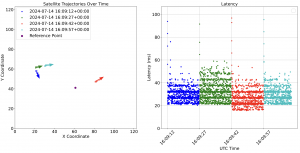
12. StarQUIC: Tuning Congestion Control Algorithms for QUIC over LEO Satellite Networks, [PDF], [Code]
Victor Kamel, Jinwei Zhao, Daoping Li, Jianping Pan
2024 ACM 2nd Workshop on LEO Networking and Communication (LEO-NET’24), doi: 10.1145/3697253.3697271
Abstract
With the deployment of mega constellations of Low-Earth-Orbit (LEO) satellites, low latency and high throughput Internet coverage is extended globally. Latency-sensitive applications can benefit from the inherent lower transmission delay of LEO satellite networks compared to traditional Geostationary-Earth-Orbit (GEO) satellite networks. Starlink employs a globally time-synchronized controller to manage the association of satellite-to-ground communication links with an interval of 15 seconds, at fixed 12-27-42-57 seconds of every minute. Latency spikes and packet losses can occur during the handover period which can degrade the performance of transport layer protocols including TCP and QUIC, which rely on similar congestion control algorithms for fair data transmission. In this paper, we investigate the impact of the frequent Starlink handover events on QUIC performance. By leveraging the predictable handover patterns to avoid unnecessary congestion window reduction, we improved the performance of QUIC by up to 35% in terms of completion time in both network emulation and real-world experiments over Starlink networks. Our approach is independent of specific loss-sensitive congestion control algorithms and can be easily generalized.

11. An eBPF-Based Trace-Driven Emulation Method for Satellite Networks, [arXiv], [Code]
Weibiao Tian, Ye Li, Jinwei Zhao, Sheng Wu, Jianping Pan
IEEE Networking Letters, doi: 10.1109/LNET.2024.3472034
Abstract
System-level performance evaluation over satellite networks often requires a simulated or emulated environment for reproducibility and low cost. However, the existing tools may not meet the needs for scenarios such as the low-earth orbit (LEO) satellite networks. To address the problem, this paper proposes and implements a trace-driven emulation method based on Linux’s eBPF technology. Building a Starlink traces collection system, we demonstrate that the method can effectively and efficiently emulate the connection conditions, and therefore provides a means for evaluating applications on local hosts.
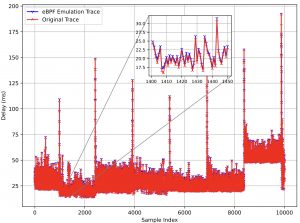
10. Adaptive Multi-Link Data Allocation for LEO Satellite Networks
Jinkai Zheng, Tom H. H. Luan, Jinwei Zhao, Guanjie Li, Yao Zhang, Jianping Pan, Nan Cheng
2024 IEEE 43rd Global Communications Conference (GLOBECOM’24)
Abstract
The rapid development of Low Earth Orbit (LEO) satellite networks has provided ubiquitous Internet access to users around the world, especially in areas where there are no terrestrial networks. However, a dish can only communicate with one of the available satellites when uploading data in the current framework, resulting in low communication efficiency. As the number of satellites continues to increase, the current framework cannot make full use of communication resources. In this paper, we first conduct a comprehensive measurement of Starlink’s network performance and report some unique features. Then, we propose an adaptive multi-link data allocation framework for LEO satellite networks where a dish can communicate with multiple satellites at the same time to improve data transmission efficiency. With this framework, data can be split into chunks and uploaded simultaneously over multiple links. Our goal is to determine the data allocation strategies to jointly optimize the transmission latency and data processing costs. To this end, we propose a deep reinforcement learning-based algorithm integrated with the traffic prediction module to determine the optimal data allocation strategies in a dynamic network environment. Through extensive simulations, we demonstrate the effectiveness of our approach compared with baselines.
9. Mobility-Aware Congestion Control for Multipath QUIC in Integrated Terrestrial Satellite Networks
Wenjun Yang, Lin Cai, Shengjie Shu, Jianping Pan
IEEE Transactions on Mobile Computing, doi: 10.1109/TMC.2024.3397164
Abstract
The Integrated Terrestrial and LEO Satellite Network (ITSN) has a high bandwidth-delay product (BDP) and high-speed movement, which makes congestion control difficult. We develop a M obility- A ware CO ngestion control (MACO) algorithm for multipath QUIC (MPQUIC) in ITSN. MACO models the dynamic interactions between MPQUIC subflows and LEO networks, including handovers and outages triggered by satellite movement, and changes in network topology and link conditions. With the knowledge of network dynamics influenced by mobility, MACO can estimate changes in path BDP without solely relying on lengthy network probing. It employs a quick start (QS) and an effective congestion avoidance (CA) mechanism based on a multipath fluid model. The QS sets an appropriate initial cwnd to shorten the slow start duration. The CA applies a square root function to quickly increase the cwnd to the equilibrium and conservatively increase when approaching the BDP. We conduct a series of experiments to evaluate MACO using network simulator 3 (ns-3) based on collected data traces on Starlink. Simulation results demonstrate that MACO can achieve upto three times higher throughput and improve the convergence performance by 70.67% against benchmark algorithms.
8. LENS: A LEO Satellite Network Measurement Dataset, [Dataset], [Poster]
Jinwei Zhao, Jianping Pan
2024 ACM 15th Multimedia Systems Conference Open-Source software & Datasets track (MMSys’24 ODS), doi: 10.1145/3625468.3652170
Abstract
Low-Earth-Orbit (LEO) satellite constellations are narrowing the performance gap between satellite networks and the terrestrial Internet. Low-latency satellite Internet offered by Starlink enables functionalities that are otherwise unachievable with the traditional geosynchronous equatorial orbit (GEO) satellite networks, including low-latency live video streaming, cloud gaming and real-time video conferencing. The absence of a comprehensive and long-term network measurement dataset with a global perspective poses significant challenges for researchers to evaluate the application performance over Starlink networks. In this paper, we introduce LENS, which is a LEO satellite network measurement dataset, collected from 13 Starlink dishes, associated with 7 Point-of-Presence (PoP) locations across 3 continents. The dataset currently consists of network latency traces from Starlink dishes with different hardware revisions, various service subscriptions and distinct sky obstruction ratios. We provide a high-level overview and analysis of the latency performance using the dataset and discuss various use cases. This dataset is useful for researchers who wish to understand the long-term network performance of Starlink and to evaluate and optimize the performance of multimedia applications over satellite networks.

7. Low Latency Live Video Streaming over a Low-Earth-Orbit Satellite Network with DASH, [Code], [Slides]
Jinwei Zhao, Jianping Pan
2024 ACM 15th Multimedia Systems Conference (MMSys’24), doi: 10.1145/3625468.3647616
DASH-IF Excellence in DASH Award Third Place
Abstract
In light of Starlink’s recent rapid growth in constructing a global low-Earth-orbit satellite constellation and offering high-speed, low-latency Internet services, the implications of utilizing Starlink for low-latency live video streaming, particularly in the context of its fluctuating latency and regular satellite handovers events, remain insufficiently explored. In this paper, we conducted a thorough measurement study on the Starlink access network, examining its performance across different protocol layers and at multiple geographical installations, including locations where laser intersatellite links are utilized in practice. We performed a comprehensive latency target-based analysis of low-latency live video streaming with three state-of-the-art adaptive bitrate (ABR) algorithms in dash.js over Starlink. We presented a novel ABR algorithm designed for low-latency live video streaming over Starlink networks which leverages satellite handover patterns observed from measurements to dynamically adjust video bitrate and playback speed. The performance evaluation of the proposed algorithm was conducted using both a purpose-built network emulator and actual Starlink networks. The results demonstrate that the proposed algorithm effectively delivers a better quality of experience for low-latency live video streaming over Starlink networks, characterized by low live latency, high average bitrate, minimal rebuffering events and reduced visual quality fluctuation.
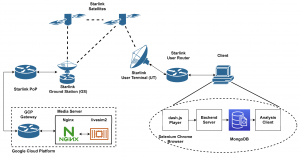
6. Measuring the Satellite Links of a LEO Network, [PDF], [Slides]
Jianping Pan, Jinwei Zhao, Lin Cai
2024 IEEE 59th International Conference on Communications (ICC’24), doi: 10.1109/ICC51166.2024.10623111
Abstract
Low-earth-orbit (LEO) satellite networks have become very popular in recent years, exemplified by Starlink, OneWeb, Kuiper and others, due to the dramatically reduced launch cost and increased demand for connectivity anytime, anywhere. After an exploration of Starlink access, core and backbone networks, in this paper we focus on the satellite access network (SAN) of Starlink around the world. Particularly, we measure the access performance in terms of one-way delay and round-trip time from user terminal (UT) to ground station (GS) and point-of-presence (PoP), both inside-out and outside-in, and even on inactive dishes. It reveals the unique characteristics of Starlink SAN in terms of satellite-GS scheduling, media access control and user contention, and sheds light on the challenges and opportunities for network protocols and applications. The paper will be complemented by public dataset release and conference on-site demo for the research and industry community.
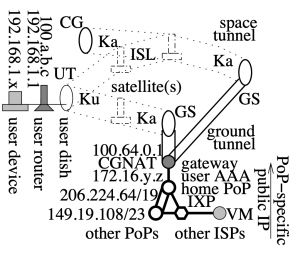
5. Measuring a Low-Earth-Orbit Satellite Network, [arXiv], [Slides]
Jianping Pan, Jinwei Zhao, Lin Cai
2023 IEEE 34th Annual International Symposium on Personal, Indoor and Mobile Radio Communications (PIMRC’23), doi: 10.1109/PIMRC56721.2023.10294034
Abstract
Starlink and alike have attracted a lot of attention recently, however, the inner working of these low-earth-orbit (LEO) satellite networks is still largely unknown. This paper presents an ongoing measurement campaign focusing on Starlink, including its satellite access networks, gateway and point-of-presence structures, and backbone and Internet connections, revealing insights applicable to other LEO satellite providers. It also highlights the challenges and research opportunities of the integrated space-air-ground-aqua network envisioned by 6G mobile communication systems, and calls for a concerted community effort from practical and experimentation aspects.

Updated backbone map in 2024 (Click to enlarge).
Also checkout “A Large-Scale IPv6-Based Measurement of the Starlink Network“.




This work partially contributes to the creation of the map of Unofficial Starlink Global Gateways & PoPs.

Our work also partially inspired Hammas’s work on Making Sense of Constellations: Methodologies for Understanding Starlink’s Scheduling Algorithms.
4. High-Reliability, Low-Latency, and Load-Balancing Multipath Routing for LEO Satellite Networks
Yufei Wang, Lin Cai, Jun Liu
2023 Biennial Symposium on Communications (BSC), doi: 10.1109/BSC57238.2023.10201829
Abstract
Being a critical part of the sixth generation mobile networks (6G) infrastructure, satellite networks have rapidly developed in recent years. With the increasing number of satellites and high mobility, the challenges of Ultra-Reliable and Low-Latency (URLL) services are increasingly prominent. The regular topology and orbital movement of low earth orbit (LEO) satellites present a new opportunity for the design of network routing for URLL services. In this paper, we propose a High-Reliability, Low-Latency, and Load-Balancing Multipath Routing (HLLMR) to support URLL services for LEO satellite networks. To ensure the reliability of satellite network transmission, a packet is transmitted through multiple paths. The path and link selection strategy avoids hotspots through load balancing to ensure end-to-end reliability and delay and minimize the link cost. Using the Starlink constellation, we illustrate the advantages of HLLMR routing in terms of delay and reliability.
3. Distance-Based Back-Pressure Routing for Load-Balancing LEO Satellite Networks
Xia Deng, Le Chang, Shouyuan Zeng, Lin Cai, Jianping Pan
IEEE Transactions on Vehicular Technology, doi: 10.1109/TVT.2022.3206616
Abstract
Featuring wide coverage and high data rate, LEO satellite networks will be an important supplement to the traditional terrestrial networks, enabling the space-air-ground integrated network service. However, effective load balancing routing strategies for LEO satellite networks need to be designed, due to the bursty characteristic of the network traffic and imbalanced regional communication load. To achieve that, we propose a Distance-based Back-Pressure Routing (DBPR) strategy for LEO satellite networks. DBPR calculates the link weights based on a novel distance-based metric, which can select uncongested short-distance paths to the destinations and distribute network traffic dynamically with low delay. To control the number of forwardings in the network, we restrict the transmission range to a rectangle region between each source-destination pair. We design DBPR in the distributed fashion without collecting the global network load information, which is suitable for LEO satellite networks with limited resources, long propagation delay, dynamic topology, etc. We analyze the network stability and prove the throughput optimality of DBPR. Simulation results demonstrate that DBPR can achieve higher throughput and lower delay, compared with the state-of-the-art strategies, especially in the environments with limited cache resource.
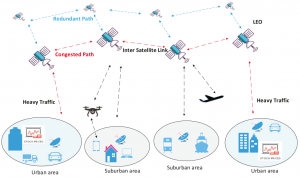
2. MM-QUIC: Mobility-aware Multipath QUIC for Satellite Networks
Wenjun Yang, Shengjie Shu, Lin Cai, Jianping Pan
2021 17th International Conference on Mobility, Sensing and Networking (MSN’21), doi: 10.1109/MSN53354.2021.00093
Abstract
The Integrated Terrestrial and LEO Satellite Network (ITSN) is promising for providing ubiquitous communication services, which attracts attention but also brings new challenges. In this regard, a new transport layer protocol, Multipath QUIC (MPQUIC) appears salient advantages in tackling with the challenging environment (e.g., large propagation delays, high-speed mobility, etc.). However, the standard congestion control algorithm of MPQUIC, Opportunistic Linked Increases Algorithm (OLIA), still encounters great challenges such as congestion window (cwnd) overshooting whenever handoff, which motivates our proposal, a Mobility-aware Multipath QUIC (MM-QUIC) congestion control algorithm. MM-QUIC leverages the periodical changes of path capacity and good similarity among disjoint subflows to quickly start a new round of transmission, and employs a multipath-based fluid model to determine the cwnd adjustment in the congestion avoidance phase. Finally, simulation results on NS-3 demonstrate that MM-QUIC can offer up to 50% throughput improvement compared to OLIA in ITSN.

1. Directed Percolation Routing for Ultra-Reliable and Low-Latency Services in Low Earth Orbit (LEO) Satellite Networks
Junhao Hu, Lin Cai, Chengcheng Zhao, Jianping Pan
2020 IEEE 92nd Vehicular Technology Conference (VTC2020-Fall), doi: 10.1109/VTC2020-Fall49728.2020.9348676
Abstract
With tens of thousands Low Earth Orbit (LEO) satellites covering Earth, LEO satellite networks can provide coverage and services that are otherwise not possible using terrestrial communication systems. The regular and dense LEO satellite constellation also provides new opportunities and challenges for network architecture and protocol design. In this paper, we propose a new routing strategy named Directed Percolation Routing (DPR), aiming to provide Ultra-Reliable and Low-Latency Communication (URLLC) services over long distances. Given the long propagation delay and uncertainty of LEO communication links, using DPR, each satellite routes a packet over several Inter-Satellite-Links (ISLs) towards the destination, without relying on link-layer retransmissions. Considering the link redundancy overhead and delay/reliability tradeoff, DPR can control the size of percolation. Using the Starlink as an example, we demonstrate that with the proposed DPR, the inter-continent propagation delay can be reduced by about 4 to 21 ms, while the reliability can be several orders higher than single-path optimal routing.
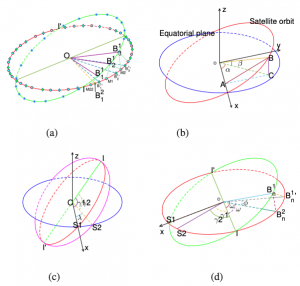
Media Coverage & Guest Posts
4. Measuring the OneWeb Satellite Network | APNIC Blog (2025/09/10)
3. Measuring the OneWeb Satellite Network | Internet Society Pulse Blog (2025/07/03)
2. Measuring the OneWeb Satellite Network (2025/06/06)
1. What Is a Starlink POP? How Ground Stations Improve Latency, Capacity | PCMag (2025/01/21)
Technical Reports
1. Analysing the Performance of Cloud Gaming over a Low-Earth Orbit Satellite Network, [Report], [Poster]
Pouria Tolouei
Invited Talks / Presentations
9. [Dagstuhl Seminar 26062] Connected Space: Challenges and Opportunities in Satellite Computing and Networking
Jianping Pan
2026/02/01
8. MIT 16.853 Advanced Satellite Engineering Guest Lecture
Jianping Pan
2025/11/26
7. Measuring low-earth-orbit satellite networks
Jianping Pan
IETF 124 SPACE RG: https://github.com/irtf-spacerg/spacerg-materials/blob/main/meetings/meetings.md (2025/11/06)
6. Routing in space-air-ground-integrated networks, [Slides]
Jianping Pan
IETF 122 Side Meeting: Large-Scale Satellite IP Networks (2025/03/18)
5. Handover Behaviors of LEO Satellite Networks and Impacts on the Transport-layer Protocols of the Internet
Jianping Pan
IETF 122 Side Meeting: Transport Layer protocol optimization in satellite network (2025/03/17)
4. LEO Satellite Networks
Jianping Pan
University at Buffalo (2024/10/01)
3. Research on Low-Earth-Orbit (LEO) Satellite Networks @PanLab, [Slides]
Jinwei Zhao
Intelligent Computation and Network Laboratory at Kanazawa University (2024/08/28) & Internet Initiative Japan (IIJ) Research Laboratory (2024/08/30)
2. Accessible and Affordable Agricultural Technologies: A Space-Air-Ground Integrated Network Approach
Jianping Pan
AraFest’24 Lightning Talks (2024/08/24)
1. Global Access to the Internet for All, Anywhere, [Slides]
Jianping Pan
IETF 120 gaia: Global Access to the Internet for All, Vancouver (2024/07/22)
Datasets
2. LENS: A LEO Satellite Network Measurement Dataset, [GitHub]
Jinwei Zhao, Jianping Pan
1. Starlink Latency and Downlink Throughput Measurement Dataset, [Zenodo]
Jinwei Zhao, Jianping Pan, doi: 10.5281/zenodo.10020034
Community Contributions
4. starlinkstatus.space, #1656
3. RIPE Atlas Probe Starlink-Denver, #60287 (Currently offline, looking for new hosts)
2. RIPE Atlas Probe Starlink-Victoria, #1009606
1. LEOScope
Tools
5. LEOViz | LEO Satellite Constellation Measurement & Visualization for Starlink / OneWeb, [GitHub]
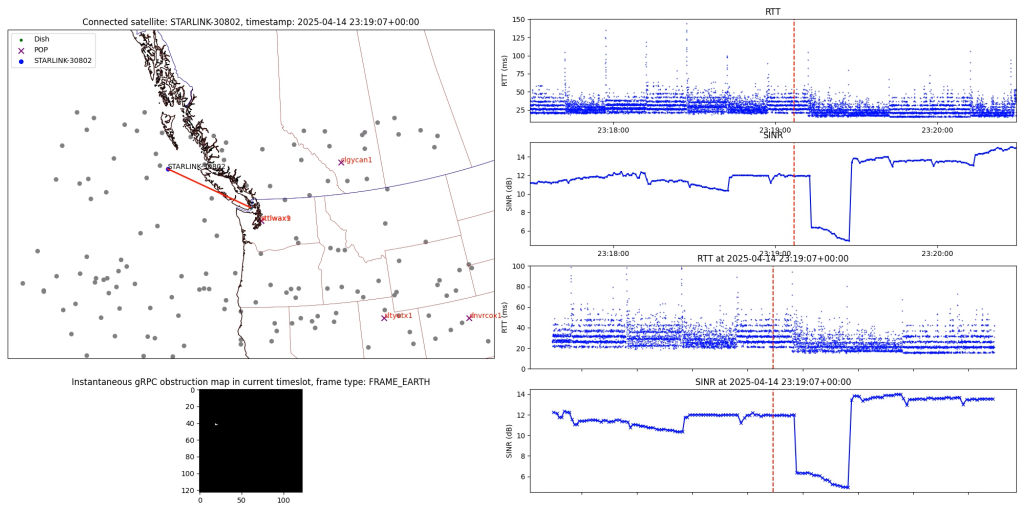
Since firmware version 2025.04.08.cr53207 / 05de8289-7bcc-476b-ad62-8cf8cc2a73fe.uterm_manifest.release, Starlink gRPC interface exposes phyRxBeamSnrAvg in the get_status method, which enables the measurement and correlation of network latency, SINR, and estimated connected satellite for research analysis. Please check the GitHub README page for more details.
4. Unofficial OneWeb SNP/PoP Map, (https://tinyurl.com/onewebmap/)
The unofficial OneWeb SNP/PoP Map illustrates the deployment of Satellite Network Portals (SNPs) and Points-of-Presence (PoPs) of the OneWeb satellite network. See also https://oac.uvic.ca/oneweb for more details.

3. starlink-lens, [GitHub]
starlink-lens is a tool to collect Starlink user terminal (UT) to gateway latency with ping and irtt, for the LENS dataset.
2. Unofficial Starlink GeoIP Map, [Code], [Data]
The unofficial Starlink GeoIP Map is a visualization of the planned naming and addressing scheme of the Starlink ISP, representing the association between user IP and Starlink’s point-of-presence (PoP).

1. Starlink Exporter, [GitHub]
Starlink Exporter is a set of tools to collect metrics from Starlink user terminal (UT)’s gRPC interface and visualize them in a Grafana dashboard.

(Since 2024/10/09)